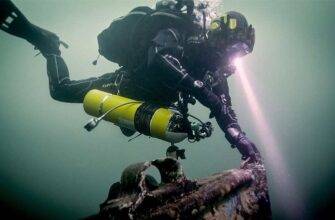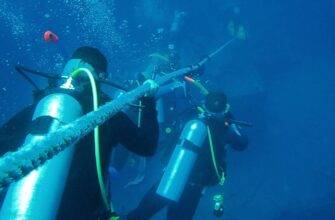Many scuba divers use the meaning of oxygen fraction P02 with the word mixture in conversation. One often hears from NITROX divers, “Get a 36 blend,” or “What’s your blend?” Well, slang expressions have penetrated deeply into diving terminology. That speaks volumes about its popularity.
The percentage of a particular gas, as well as the gas fractions, do not change during open-circuit diving. However, the partial pressure of gases changes. If we dive using air, the E02 will be 0.21 both at the surface and at the bottom, and the partial pressures of oxygen (O2) and nitrogen will increase in direct proportion to the increase of the absolute pressure (ambient pressure).
Correspondingly, during surfacing, the partial pressures will also decrease in proportion to the decrease in ambient pressure.
Below are three formulas that are used to calculations when using NITROX mixtures.
1 P02 = P02 x P=> DOZA
2 P = P02 : P02 => DOSAGE
3 G02 = P02 : P => Mixture
4. Knowing the partial pressure of oxygen (PO2), we can determine the maximum oxygen tolerable dive time (oxygen limit time).
5. By calculating the pressure (P), we determine the maximum dive depth for a given mixture of NITROX (oxygen depth limit).
6. By calculating the oxygen fraction (P02), we find the optimal percentage of oxygen in the NAITROX mixture for diving to a specific depth.
The easiest way to remember these three formulas is the diagram below. The three components are placed in the shape of a crystal: PO2 in the upper triangle, ?02 in the lower left triangle, and P in the lower right triangle. The horizontal line separating PO2 from P02 and P denotes division. The vertical line separating P02 and P indicates multiplication.
This schematic representation is called a Dalton crystal.
Using this diagram, you will be able to make an equation by covering the unknown component or what you need to find with the palm of your hand.
For example: if you cover the FO2, you’re left with FO2 x P,
if you cover FO2, you get the equation FO2 : P, if you cover P, it will be FO2 : FO2. Dalton’s crystal will serve you well in further calculations.
Let’s determine the partial pressure of oxygen and nitrogen (in ATA) in the air at sea level. Let’s make an equation for oxygen:
RO2 = FO2 x P
If we substitute nitrogen (N2) instead of oxygen in Dalton’s Crystal, we get the equation for nitrogen:
PN2 = FN2 x P
In air at sea level, FO2 is 0.21, FN2 is 0.79, and P is 1 ATA.
FO2 x P = PO2 substitute values 0.21 x 1 ATA = 0.21 ATA FN2 x P = PN2 substitute values 0.79 x 1 ATA = 0.79 ATA
We obtain that in the air at sea level the partial pressure of oxygen is 0.21 ATA and the partial pressure of nitrogen is 0.79 ATA.
Using Dalton’s formula we check our result.
PO2 + PN2 = P gives 0.21 ATA + 0.79 ATA = 1 ATA
Checking confirms that the result is correct.





